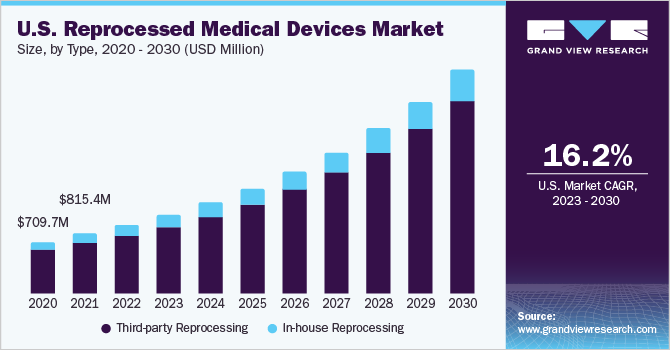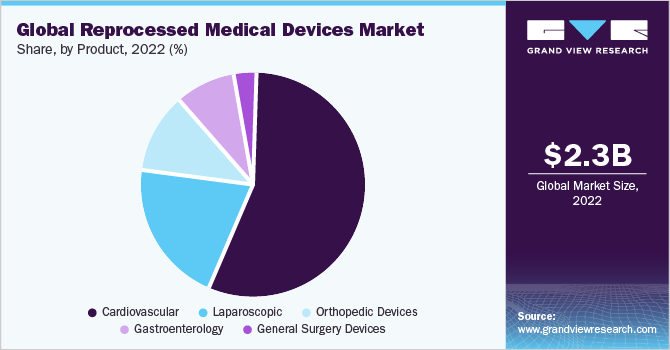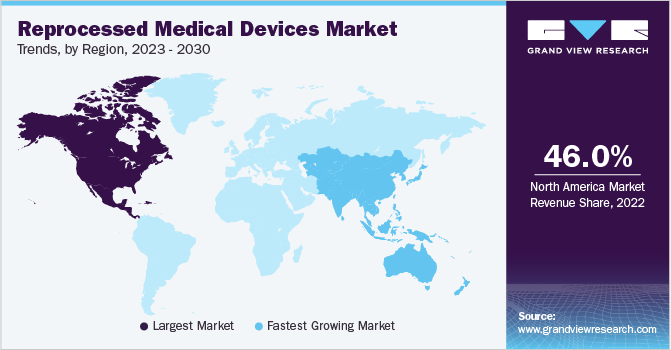- Home
- »
- Medical Devices
- »
-
Reprocessed Medical Devices Market Size Report, 2030GVR Report cover
![Reprocessed Medical Devices Market Size, Share & Trends Report]()
Reprocessed Medical Devices Market Size, Share & Trends Analysis Report By Product (Cardiovascular, Laparoscopic), By Type (Third-party, In-house) By End-use (Hospitals, Home Healthcare), And Segment Forecasts, 2023 - 2030
- Report ID: 978-1-68038-848-0
- Number of Report Pages: 100
- Format: PDF, Horizon Databook
- Historical Range: 2018 - 2021
- Forecast Period: 2023 - 2030
- Industry: Healthcare
Market Size & Trends
The global reprocessed medical devices market size was estimated at USD 2.3 billion in 2022 and is expected to grow at a compound annual growth rate (CAGR) of 16.8% from 2023 to 2030. The market is driven by the need to reduce medical waste in healthcare settings, along with the cost benefits and increasing awareness about the advantages of reprocessed devices. In addition, factors, such as the growing prevalence of cardiovascular disorders, a rising geriatric population, and improving healthcare infrastructure, are contributing to market growth. Furthermore, government initiatives to promote equipment reprocessing are expected to create significant business opportunities for the market. Reprocessing of medical equipment provides a solution that reduces medical waste, decreases Greenhouse Gas (GHG) emissions, and encourages a safer, cleaner, and more environmentally friendly healthcare system. For instance, as per the data provided by the Association of Medical Device Reprocessors (AMDR), in 2021, 20.3 million pounds of medical waste was diverted because of the use of reprocessed medical devices. Furthermore, major hospitals are opting for alternate options to cut down on capital investments by partnering with medical device reprocessing companies. According to AMDR, in 2020, medical device reprocessing saved U.S. hospitals USD 372 million as reprocessed devices cost 25-40% less and help in reducing medical waste.

Also, AMDR data indicates that if the reprocessing practices of the top 10% performing hospitals were replicated in all other hospitals utilizing reprocessed devices, the U.S. healthcare system could have saved an additional USD 2.28 billion in the year 2020.The rising prevalence of chronic diseases is fueling the market demand for reprocessed medical devices utilized in various surgical procedures. The adoption of these devices enables healthcare facilities to achieve cost savings without compromising patient care or safety. For instance, the cost of a new coronary sinus catheter is approximately USD 500, while the reprocessed alternative is priced at around USD 250.
Similarly, the steerable sheath is priced over USD 900, whereas the reprocessed version is available for approximately USD 460, resulting in a substantial cost reduction of nearly 50%. The aforementioned factors are anticipated to contribute to the industry's development. The COVID-19 pandemic has significantly impacted the market. The suspension of medical procedures had adverse effects on the cash flows, financial condition, operational performance, and overall business of medical device companies. For instance, Stryker Sustainability Solutions’ revenue decreased by 3.6% in 2020 compared to 2019. However, as healthcare systems prioritize affordability and sustainability, the market is expected to grow at a significant CAGR over the forecast period.
Type Insights
Based on the type, the market is segmented into third-party reprocessing & in-house reprocessing. The third-party reprocessing segment held the largest revenue share of over 84% in 2022. These third-party players receive used medical devices that would otherwise be discarded as medical waste, and use various cleaning, sterilization, and refurbishment techniques to make them suitable for reuse. It is estimated that AMDR member companies reprocess a wide range of clinical devices used in orthopedics, cardiology, and respiratory therapy, serving outpatient surgery centers, and hospitals.In-house reprocessing refers to the practice of a healthcare facility, such as a hospital, sterilizing and refurbishing medical devices for reuse on their own premises.
For instance, Mayo Clinic has implemented recycling systems for a wide range of items, including surgical devices. Through surgical product and device reprocessing, Mayo Clinic successfully diverted more than 22,000 pounds of waste from landfills each year. However, it is a highly regulated industry, and the reprocessors must meet regulatory standards and guidelines to ensure the safety and efficacy of the reprocessed devices. The program should include appropriate equipment, trained personnel, documented procedures, and ongoing quality control measures.
End-Use Insights
On the basis of end-use, hospitals held a substantial share of over 40% of the overall market in 2022. This can be attributed to the high requirement and utilization of reprocessed medical devices to reduce the cost and medical waste generation associated with the original medical equipment. According to the AMDR’s 2019 survey, 8,622 hospitals and outpatient care centers saved more than 18 million pounds of medical waste and attained over 20 million U.S. dollars in savings from disposing of waste. This generated a collective savings of around USD 544 million and over 2,000 jobs. Apart from the environmental implications, healthcare leadership also prioritizes the quality of reprocessed devices - studies have highlighted that re-used medical instruments can be more reliable than new medical devices.The home healthcare segment is predicted to grow at a moderate rate over the forecast period as a result of the rising need for low-cost home equipment. Reprocessed home medical equipment includes orthopedic devices, patient monitoring systems, and external support devices, which enhance the patient’s mobility profile at home. Furthermore, the increasing scope for incorporation of reprocessed products in home healthcare due to a lesser number of home medical device suppliers is presumed to trigger growth prospects.
Product Insights
In 2022, the cardiovascular segment held the largest share of over 55% owing to the extensive utilization of these products in cardiovascular surgeries and diagnostics. These devices include blood pressure cuffs, cardiac positioning and stabilization devices, blood pressure monitoring, electrophysiology cables, and diagnostic electrophysiology catheters. Increasing FDA approvals for reprocessed cardiovascular products are contributing to the substantial share of the segment.The rise in cardiovascular surgeries and treatments is creating a demand for more cost-saving alternatives, fueling segment growth.

Moreover, the advent of low-cost and single-use cardiovascular reprocessed devices has been advantageous and driven the segment's expansion. The laparoscopy segment accounted for the second-largest share of the industry in 2022. The high amount of waste generation as a result of the usage of disposable devices is driving the demand for reprocessed laparoscopic devices. Growing demand for minimally invasive techniques is expected to present opportunities for more reprocessing approvals pertaining to laparoscopy, thereby contributing to the growth of this segment.
Regional Insights
North America accounted for the largest revenue share of over 46% of the global market. The increasing need to reduce hospital waste and potential damage to the environment caused due to the rising waste landfills in the region is a major driver of the market. In addition, favorable government initiatives and strategic initiatives taken by healthcare organizations to promote awareness pertaining to reprocessing of equipment are expected to provide this market with significant growth opportunities. For instance, Practice Greenhealth, a renowned sustainable healthcare organization, offers environmental solutions to a broad network of over 1,500 hospitals and health systems across the U.S. and Canada.

Their partnership opportunities extend to various entities within the healthcare sector, including hospitals, health systems, community health organizations, NGOs, government agencies, academic institutions, and participants in the healthcare value chain. On the other hand, Asia Pacific is expected to register the fastest growth rate over the forecast period. The growing economy, increasing prevalence of chronic conditions, and rising need to curb hospital costs have all contributed to the growing regional market for reprocessed medical devices. Developing countries, such as China and India, have experienced a surge in the occurrence of chronic diseases, similar to other parts of the world. This has led to a heavier focus on healthcare, with governments investing in healthcare infrastructure but being limited in their spending. Thus, this has created ahighproduct demand.
Key Companies & Market Share Insights
The growing number of companies, efficient distribution agreements, and frequent product approvals have led to an increase in market competition. As a result, competitive rivalry in the industry is anticipated to be high over the forecast period. For instance, in March 2023, Vanguard AG signed the 3rd edition of the Dutch Green Deal. This deal is a collaboration involving industry associations, government departments, and other organizations, all committed to advancing sustainable development in the Netherlands. To empower their efforts, Vanguard is also working in tandem with the scientific and professional network, Landelijk Netwerk de Groene OK, to achieve their goal: achieving CO2-neutral care. Some of the key companies in the global reprocessed medical devices market are:
-
Stryker
-
Innovative Health
-
NEScientific, Inc.
-
Medline Industries, LP.
-
Arjo
-
Vanguard AG
-
Cardinal Health
-
SureTek Medical
-
Soma Tech Intl
-
Johnson & Johnson MedTech
Reprocessed Medical Devices Market Report Scope
Report Attribute
Details
The market size value in 2023
USD 2.7 billion
The revenue forecast in 2030
USD 8.0 billion
Growth rate
CAGR of 16.8% from 2023 to 2030
The base year for estimation
2022
Historical data
2018 - 2021
Forecast period
2023 - 2030
Report updated
June 2023
Quantitative units
Revenue in USD million/billion and CAGR from 2023 to 2030
Report coverage
Revenue forecast, company ranking, competitive landscape, growth factors, and trends
Segments covered
Product, type, end-use, region
Regional scope
North America; Europe; Asia Pacific; Latin America; MEA
Country scope
U.S.; Canada; Germany; UK; Spain; France; Italy; Sweden; Norway; Denmark; Japan; China; India; Australia; Thailand; South Korea; Brazil; Mexico; Argentina; South Africa; UAE; Saudi Arabia; Kuwait
Key companies profiled
Stryker; Innovative Health; NEScientific, Inc.; Medline Industries, LP; Arjo; Vanguard AG; Cardinal Health; SureTek Medical; Soma Tech Intl; Johnson & Johnson MedTech
Customization scope
Free report customization (equivalent to up to 8 analyst’s working days) with purchase. Addition or alteration to country, regional, and segment scope
Pricing and purchase options
Avail of customized purchase options to meet your exact research needs. Explore purchase options
Global Reprocessed Medical Devices Market Report Segmentation
This report forecasts revenue growth and provides an analysis of the latest trends in each of the sub-segments from 2018 to 2030. For this report, Grand View Research has segmented the global reprocessed medical devices market based on product, type, end-use, and region:
-
Product Outlook (Revenue, USD Million, 2018 - 2030)
-
Cardiovascular
-
Blood Pressure Cuffs
-
Positioning Devices
-
Cardiac Stabilization Devices
-
Diagnostic Electrophysiology Catheters
-
Electrophysiology Cables
-
Deep Vein Thrombosis Compression Sleeves
-
-
Laparoscopic
-
Harmonic Scalpels
-
Endoscopic Trocars
-
-
Gastroenterology
-
Biopsy Forceps
-
Others
-
-
General Surgery Devices
-
Balloon Inflation Devices
-
Pressure Bags
-
- Orthopedic Devices
-
-
Type Outlook (Revenue, USD Million, 2018 - 2030)
-
Third-party Reprocessing
-
In-house Reprocessing
-
-
End-use Outlook (Revenue, USD Million, 2018 - 2030)
-
Hospitals
-
Home Healthcare
-
Others
-
-
Regional Outlook (Revenue, USD Million, 2018 - 2030)
-
North America
-
U.S.
-
Canada
-
-
Europe
-
UK
-
Germany
-
France
-
Italy
-
Spain
-
Denmark
-
Sweden
-
Norway
-
-
Asia Pacific
-
Japan
-
China
-
India
-
Australia
-
South Korea
-
Thailand
-
-
Latin America
-
Brazil
-
Mexico
-
Argentina
-
-
Middle East and Africa
-
South Africa
-
Saudi Arabia
-
UAE
-
Kuwait
-
-
Frequently Asked Questions About This Report
b. The global reprocessed medical devices market size was estimated at USD 2.3 billion in 2022 and is expected to reach USD 2.7 billion in 2023.
b. The global reprocessed medical devices market is expected to grow at a compound annual growth rate of 16.8% from 2023 to 2030 to reach USD 8.0 billion by 2030.
b. North America dominated the reprocessed medical devices market with a share of 46.8% in 2022. This is attributable to favorable government initiatives to promote awareness pertaining to reprocessing of equipment, the presence of stringent regulatory framework and rising need to curtail the waste generation and potential damage to the environment.
b. Some key players operating in the reprocessed medical devices market include Stryker, Innovative Health, NEScientific, Inc., Medline Industries, LP., Arjo, Vanguard AG., Cardinal Health, SureTek Medical, Soma Tech Intl, and Johnson & Johnson MedTech
b. Key factors that are driving the reprocessed medical devices market growth include clinical urgency to reduce the generation of medical waste in hospitals and other healthcare settings and rising adoption of reprocessed medical devices.
Share this report with your colleague or friend.
![gvr icn]()
NEED A CUSTOM REPORT?
We can customize every report - free of charge - including purchasing stand-alone sections or country-level reports, as well as offer affordable discounts for start-ups & universities. Contact us now
![Certified Icon]()
We are GDPR and CCPA compliant! Your transaction & personal information is safe and secure. For more details, please read our privacy policy.
We are committed towards customer satisfaction, and quality service.
"The quality of research they have done for us has been excellent."





